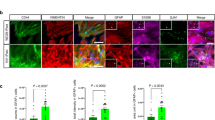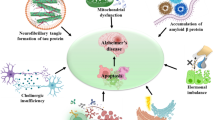Abstract
Delineation of how cell death mechanisms associated with Parkinson’s disease (PD) interact and whether they converge would help identify targets for neuroprotective therapies. The purpose of this study was to use a cellular model to address these issues. Catecholaminergic SH-SY5Y neuroblastoma cells were exposed to a range of compounds (dopamine, rotenone, 5,8-dihydroxy-1,4-naphtho-107 quinone [naphthazarin], and Z-Ile-Glu(OBut)-Ala-Leu-al [PSI]) that are neurotoxic when applied to these cells for extended periods of times at specific concentrations. At the concentrations used, these compounds cause cellular stress via mechanisms that mimic those associated with causing neurodegeneration in PD, namely oxidative stress (dopamine), mitochondrial dysfunction (rotenone), lysosomal dysfunction (naphthazarin), and proteasomal dysfunction (PSI). The compounds were applied to the SH-SY5Y cells either alone or in pairs. When applied separately, the compounds produced a significant decrease in cell viability confirming that oxidative stress, mitochondrial, proteosomal, or lysosomal dysfunction can individually result in catecholaminergic cell death. When the compounds were applied in pairs, some of the combinations produced synergistic effects. Analysis of these interactions indicates that proteasomal, lysosomal, and mitochondrial dysfunction is exacerbated by dopamine-induced oxidative stress. Furthermore, inhibition of the proteasome or lysosome or increasing oxidative stress has a synergistic effect on cell viability when combined with mitochondrial dysfunction, suggesting that all cell death mechanisms impair mitochondrial function. Finally, we show that there are reciprocal relationships between oxidative stress, proteasomal dysfunction, and mitochondrial dysfunction, whereas lysosome dysfunction appears to mediate cell death via an independent pathway. Given the highly interactive nature of the various cell death mechanisms linked with PD, we predict that effective neuroprotective strategies should target multiple sites in these pathways, for example oxidative stress and mitochondria.






Similar content being viewed by others
References
Ardley HC, Scott GB, Rose SA, Tan NG, Robinson PA (2004) UCH-L1 aggresome formation in response to proteasome impairment indicates a role in inclusion formation in Parkinson’s disease. J Neurochem 90:379–391. doi:10.1111/j.1471-4159.2004.02485.x
Betarbet R, Canet-Aviles RM, Sherer TB, Mastroberardino PG, McLendon C, Kim JH, Lund S, Na HM, Taylor G, Bence NF, Kopito R, Seo BB, Yagi T, Yagi A, Klinefelter G, Cookson MR, Greenamyre JT (2006) Intersecting pathways to neurodegeneration in Parkinson’s disease: effects of the pesticide rotenone on DJ-1, alpha-synuclein, and the ubiquitin-proteasome system. Neurobiol Dis 22:404–420
Braak H, Del Tredici K, Rub U, de Vos RA, Jansen Steur EN, Braak E (2003) Staging of brain pathology related to sporadic Parkinson’s disease. Neurobiol Aging 24:197–211
Caneda-Ferron B, De Girolamo LA, Costa T, Beck KE, Layfield R, Billett EE (2008) Assessment of the direct and indirect effects of MPP+ and dopamine on the human proteasome: implications for Parkinson’s disease aetiology. J Neurochem 105:225–238. doi:10.1111/j.1471-4159.2007.05130.x
Cooper AA, Gitler AD, Cashikar A, Haynes CM, Hill KJ, Bhullar B, Liu K, Xu K, Strathearn KE, Liu F, Cao S, Caldwell KA, Caldwell GA, Marsischky G, Kolodner RD, Labaer J, Rochet JC, Bonini NM, Lindquist S (2006) Alpha-synuclein blocks ER-Golgi traffic and Rab1 rescues neuron loss in Parkinson’s models. Science 313:324–328
Goldman JE, Yen SH, Chiu FC, Peress NS (1983) Lewy bodies of Parkinson’s disease contain neurofilament antigens. Science 221:1082–1084
Greenamyre JT, Hastings TG (2004) Biomedicine. Parkinson’s—divergent causes, convergent mechanisms. Science 304:1120–1122
Hoglinger GU, Carrard G, Michel PP, Medja F, Lombes A, Ruberg M, Friguet B, Hirsch EC (2003) Dysfunction of mitochondrial complex I and the proteasome: interactions between two biochemical deficits in a cellular model of Parkinson’s disease. J Neurochem 86:1297–1307
Imashuku S, Inui A, Nakamura T, Tanaka J, Miyake S (1973) Catecholamine metabolism in tissue culture cells of a neuroblastoma. J Clin Endocrinol Metab 36:931–936
Jenner P (2003) Oxidative stress in Parkinson’s disease. Ann Neurol 53(Suppl 3):S26–S36; discussion S36–S28. doi:10.1002/ana.10483
Lannuzel A, Michel PP, Hoglinger GU, Champy P, Jousset A, Medja F, Lombes A, Darios F, Gleye C, Laurens A, Hocquemiller R, Hirsch EC, Ruberg M (2003) The mitochondrial complex I inhibitor annonacin is toxic to mesencephalic dopaminergic neurons by impairment of energy metabolism. Neuroscience 121:287–296
Li Z, Arnaud L, Rockwell P, Figueiredo-Pereira ME (2004) A single amino acid substitution in a proteasome subunit triggers aggregation of ubiquitinated proteins in stressed neuronal cells. J Neurochem 90:19–28. doi:10.1111/j.1471-4159.2004.02456.x
Nuber S, Petrasch-Parwez E, Winner B, Winkler J, von Horsten S, Schmidt T, Boy J, Kuhn M, Nguyen HP, Teismann P, Schulz JB, Neumann M, Pichler BJ, Reischl G, Holzmann C, Schmitt I, Bornemann A, Kuhn W, Zimmermann F, Servadio A, Riess O (2008) Neurodegeneration and motor dysfunction in a conditional model of Parkinson’s disease. J Neurosci 28:2471–2484. doi:10.1523/JNEUROSCI.3040-07.2008
Olanow WC (2008) Levodopa/dopamine replacement strategies in Parkinson’s disease—future directions. Mov Disord 23:S613–S622
Pan T, Kondo S, Le W, Jankovic J (2008) The role of autophagy-lysosome pathway in neurodegeneration associated with Parkinson’s disease. Brain 131:1969–1978. doi:10.1093/brain/awm318
Richfield EK, Thiruchelvam MJ, Cory-Slechta DA, Wuertzer C, Gainetdinov RR, Caron MG, Di Monte DA, Federoff HJ (2002) Behavioral and neurochemical effects of wild-type and mutated human alpha-synuclein in transgenic mice. Exp Neurol 175:35–48. doi:10.1006/exnr.2002.7882
Rideout HJ, Larsen KE, Sulzer D, Stefanis L (2001) Proteasomal inhibition leads to formation of ubiquitin/alpha-synuclein-immunoreactive inclusions in PC12 cells. J Neurochem 78:899–908
Sherer TB, Kim JH, Betarbet R, Greenamyre JT (2003) Subcutaneous rotenone exposure causes highly selective dopaminergic degeneration and alpha-synuclein aggregation. Exp Neurol 179:9–16
Sherer TB, Richardson JR, Testa CM, Seo BB, Panov AV, Yagi T, Matsuno-Yagi A, Miller GW, Greenamyre JT (2007) Mechanism of toxicity of pesticides acting at complex I: relevance to environmental etiologies of Parkinson’s disease. J Neurochem 100:1469–1479. doi:10.1111/j.1471-4159.2006.04333.x
Testa CM, Sherer TB, Greenamyre JT (2005) Rotenone induces oxidative stress and dopaminergic neuron damage in organotypic substantia nigra cultures. Brain Res Mol Brain Res 134:109–118. doi:10.1016/j.molbrainres.2004.11.007
von Bohlen Und Halbach O, rieglstein K, Schober A, Schulz JB (2004) The dopaminergic nigrostriatal system: development, physiology, disease. Cell Tissue Res 318:3. doi:10.1007/s00441-004-0963-x
Wislet-Gendebien S, D’Souza C, Kawarai T, St George-Hyslop P, Westaway D, Fraser P, Tandon A (2006) Cytosolic proteins regulate alpha-synuclein dissociation from presynaptic membranes. J Biol Chem 281:32148–32155. doi:10.1074/jbc.M605965200
Wislet-Gendebien S, Visanji NP, Whitehead SN, Marsilio D, Hou W, Figeys D, Fraser PE, Bennett SA, Tandon A (2008) Differential regulation of wild-type and mutant alpha-synuclein binding to synaptic membranes by cytosolic factors. BMC Neurosci 9:92. doi:10.1186/1471-2202-9-92
Yong-Kee C, Salomonczyk D, Nash J (2011) Development and validation of a screening assay for the evaluation of putative neuroprotective agents in the treatment of Parkinson’s disease. Neurotox Res 19:519–526
Yong-Kee CJ, Sidorova E, Hanif A, Perera G, Nash JE (2012) Mitochondrial dysfunction precedes other sub-cellular abnormalities in an in vitro model linked with cell death in Parkinson’s disease. Neurotox Res 21:185–194
Acknowledgments
We would like to thank NSERC, the Michael J Fox Foundation, and the University of Toronto for funding this research. Joanne Nash was a Michael J Fox research fellow when conducting this research at the Toronto Western Research Institute.
Author information
Authors and Affiliations
Corresponding author
Rights and permissions
About this article
Cite this article
Yong-Kee, C.J., Warre, R., Monnier, P.P. et al. Evidence for Synergism Between Cell Death Mechanisms in a Cellular Model of Neurodegeneration in Parkinson’s Disease. Neurotox Res 22, 355–364 (2012). https://doi.org/10.1007/s12640-012-9325-8
Received:
Revised:
Accepted:
Published:
Issue Date:
DOI: https://doi.org/10.1007/s12640-012-9325-8




